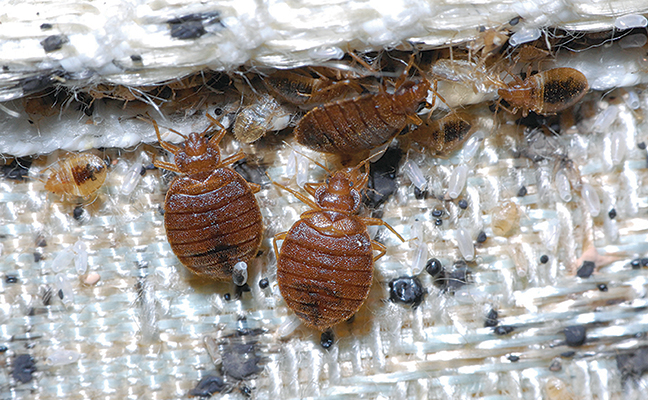- Clients don’t always choose the best program, but you can still give your best effort.
- If you can’t catch infestations while they are still small, it is even more important to practice error-free control.

Although proactive bed bug control is best at multi-family accounts, reactive still can be effective. Photo courtesy of, and copyrighted by, Gene White, pmimages@earthlink.net
I have banged the drum before for a proactive program — the best strategy for multi-family housing communities — but some clients may not be ready to adopt one. If you are contracted to perform a reactive program, you are doing “second-best” bed bug control. Until you can negotiate a better program, you will need to get the best results you can with the program you have. Here are three tips for minimizing your pain:
1. Inspect adjacent units to infestations.
The worst-case scenario is the undetected heavy infestation. It supplies a constant source of bed bugs to adjacent units, other units regularly visited, and common areas. All of these are precursors to future infestations, and can cause great frustration when bed bugs show up next door regularly in onesies/twosies. The single best strategy for maximizing a reactive program is to get access to adjacent units. Finding an unreported heavy infestation is pay dirt. Constantly treating the units next to them is like playing a constant game of catch-up.
2. Follow up on treatments to ensure elimination.
Be sure to set up another service to confirm control has been achieved. Even if you only find a bed bug or two, the infestation is still active and capable of recovering. Never rely on a single product, no matter how well it has worked in the past. Resistant populations can astound you with their immunity. The best practice is to schedule a final trip even after you find no bugs. It may seem unnecessary, but in reactive programs, extra care is warranted.
3. Identify recurring infestations for special care.
You may regularly encounter chronic infestations. They may seem to clean up easily, but months later, they are infested again. This is not merely bad luck. If the tenants don’t know or won’t say how they come to be infested, install interceptors and inspect on a regular schedule to identify re-infestations early. Bed bug populations can rebound within a few months.
When you have to wait for tenants to report an infestation, you likely will be coming into an established population — and those are always harder to eliminate. Such situations make it even more important to follow through until you can confirm elimination.
One proactive strategy is to apply silica-based desiccant dusts thoroughly behind baseboards, under tack strips, and to electrical outlets. Recognize the need to be especially thorough, and allot more time for treatments in your schedule. Have a pre-arranged plan for dealing with hoarders and heavily cluttered units.
Even though you are at a disadvantage in a reactive program, you can take steps to get the best possible results in a bad situation.
The post Do your best with ‘second-best’ bed bug control appeared first on Pest Management Professional.
from Pest Management Professional https://www.mypmp.net/2020/01/02/do-your-best-with-second-best-bed-bug-control/
Sacramento CA
No comments:
Post a Comment